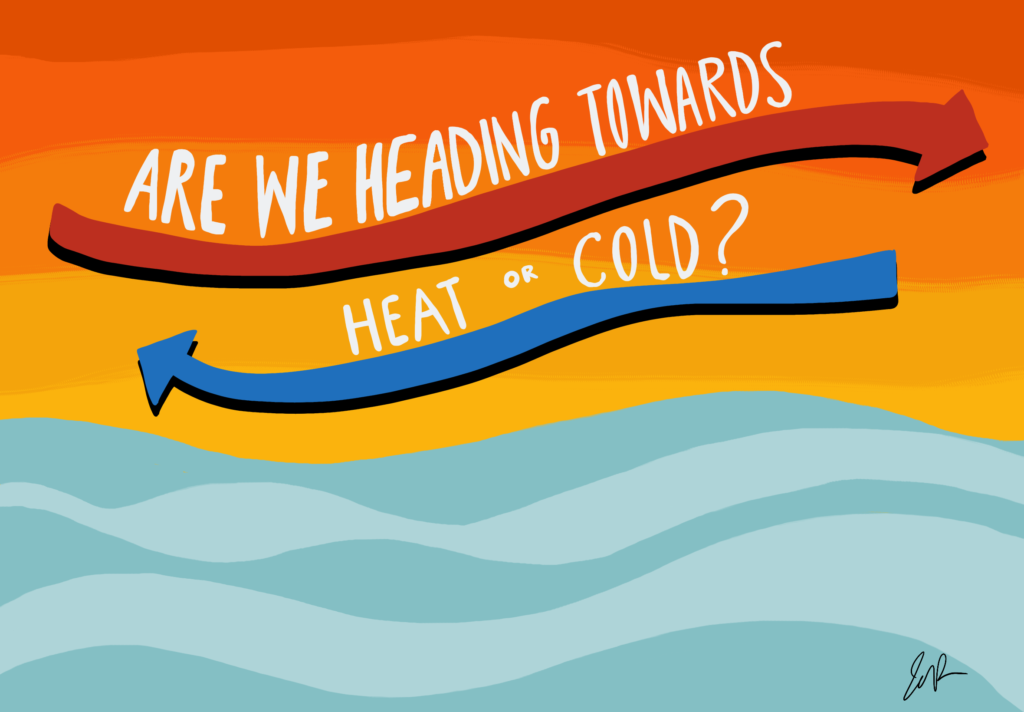
Global warming might actually cause global cooling? Now that’s something you’ve probably never heard before.
The potential for a period of glaciation following global warming comes down to two important factors: ocean circulation and the tilt of the Earth.
First, let’s break down what ocean circulation is and why it is so important. Put simply, ocean water is constantly moving all across the globe — between seas, up and down, quickly and slowly. This movement is driven by a confluence of factors. Surface level currents are influenced primarily by wind patterns and the Coriolis Effect, which describes how the spinning of the Earth impacts the direction of moving objects on its surface—learn more here! Meanwhile, temperature (thermo) and salinity (haline) are the main forces behind the deeper currents because colder and saltier water is denser than warmer and less salty water. Surface winds also contribute to upwelling, which is when cold, nutrient rich water is pulled up from ocean depths because wind is pushing the surface water in a different direction, while geologic structures and seismic events affect deeper water circulation (NASA).
Given that oceans cover over 70 percent of Earth’s surface, it is unsurprising that ocean circulation has a substantial impact on our planet’s climate. In fact, thermohaline circulation is one of the reasons the ocean has been able to absorb so much of the excess heat trapped by anthropogenic (human caused) greenhouse gasses, thus delaying much of the impending climate catastrophe (NOAA). But beyond climate change, ocean circulation provides one of the foundations for all of Earth’s life by carrying cold air and water towards the equator and warmer air and water towards the poles. This exchange of heat acts as a damper that allows for more moderate temperatures to be distributed throughout the globe despite the uneven input of solar radiation (NOAA). To visualize this uneven input, consider how the equator, or the part of the globe closest to the sun, receives more direct sunlight for longer hours, while at the poles the radiation must travel further and strikes the atmosphere at an angle.
As of the last couple of centuries, much of the scientific community is concerned that warming global temperatures are slowing, with the potential of fully halting, the overturning circulation of the world’s oceans. This is largely due to the melting of polar ice sheets and glaciers, which release freshwater into the ocean where normally the water has unusually high salinity due to the freezing of ice sheets. The decreased salinity of the water in these cold regions where seawater generally sinks and deep water is formed means that that water is less heavy, so the sinking motion is inhibited (Jones). Slowing circulation has many potential implications, but we will discuss the predicted impact on climate below.
Meanwhile, a phenomenon related to Milankovitch cycles called the obliquity or tilt of the Earth as it rotates around the sun plays an important role in dictating longer term periods of glaciation or deglaciation. Simply put, during roughly forty thousand years cycles the Earth’s vertical axis shifts between 22.1 and 24.5 degrees. While at higher tilts, closer to 24.5 degrees, seasons are more extreme and ice sheets at the poles melt due to the increased solar radiation they receive during the summers. At lower tilts, closer to 22.1 degrees, seasons are more mild and ice sheets and glaciers grow at the poles, increasing the radiation reflected away from Earth and back into space, thus decreasing overall temperatures (NASA Science). At the moment, Earth is roughly in the middle and moving slowly towards a lower degree tilt, meaning the planet should (barring global warming) be getting gradually colder and even has the potential to tip into an ice age with very little prodding.
While the planet’s tilt suggests that the climate should be getting colder, slowing ocean circulation initially seems to suggest rapid heating because there will be less upwelling cool water to absorb carbon dioxide and heat from the atmosphere (Escueta). However, slower thermohaline circulation, including the important Atlantic Meridional Overturning Circulation (AMOC), will not only cause less carbon dioxide to be absorbed by the oceans, but will also lead to a greater temperature differential between the poles and the equator. According to some scientists, this may cause the expansion of glacial ice sheets at the poles, in turn increasing solar radiation reflected back into space, thus further cooling the poles and triggering a miniature ice age (Sexton). Despite this, others claim that this is unlikely to happen because there is already an exorbitant concentration of greenhouse gasses in the atmosphere to have any substantial cooling effect (Hugus), while yet others suggest that there will be a mini ice age, but only for northwestern Europe (McGuire).
Although the future is uncertain, we can be sure that the slowing and halting of our global conveyor belt system of ocean circulation will mean dramatic consequences for the climate. It is therefore crucial that we continue to work to mitigate the impacts of climate change and to preserve our oceans, whether through individual actions like lobbying, buying green, or through collective actions like boycotting fossil fuel companies and electrifying our energy system (switching from gas and diesel sources to electricity). Continue to follow The Earth Chronicles to stay up to date on environmental news, and most importantly, remember that we all have the power to keep our oceans and our world turning.
The views and opinions expressed are those of the authors and do not necessarily reflect nor represent the Earth Chronicles and its editorial board.




